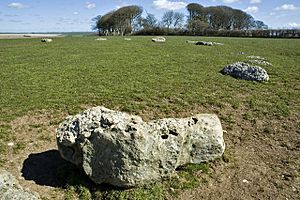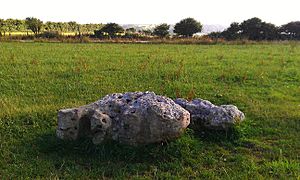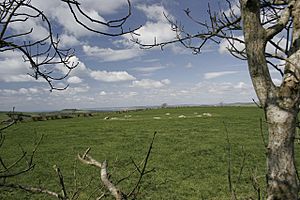Kingston Russell Stone Circle facts for kids

View across the western half of the circle
|
|
| Location | Kingston Russell |
|---|---|
| Coordinates | 50°41′19″N 2°35′56″W / 50.688526°N 2.598998°W |
| Type | Stone circle |
| History | |
| Periods | Neolithic / Bronze Age |
The Kingston Russell Stone Circle, also called the Gorwell Circle, is an ancient stone circle in Dorset, England. It sits between the villages of Abbotsbury and Littlebredy. Experts believe it was built during the Bronze Age, a long time ago.
This stone circle is part of a tradition that spread across Britain, Ireland, and Brittany. People built these circles between 3,300 and 900 BCE. We don't know exactly why they built them. But archaeologists think they were likely important religious places. The stones might have had special, even supernatural, meanings.
Many stone circles were built in the Dorset area. They are usually made from a type of rock called sarsen stone. These circles are often smaller than those found in other places. The Kingston Russell ring is the biggest one in Dorset. It measures about 24 by 27 metres (79 by 89 feet) across. It has eighteen sarsen stones arranged in an oval shape. So far, archaeologists have not dug up or studied this site in great detail.
Contents
Where is the Stone Circle Located?
The Kingston Russell Stone Circle is found on a chalk ridge. This ridge is west of Portesham. From here, you can see Abbotsbury and the sea. The site is on open downland, which means it's on high, grassy hills. It sits about 189 metres (620 feet) above sea level.
The historic house of Kingston Russell is about 1.6 kilometres (1 mile) north of the circle. A ruined ancient burial place, called The Grey Mare and her Colts, is also nearby. It's a short distance to the southeast.
The circle is also known as the Gorwell Circle. This name comes from Gorwell Farm, which is to the south. You can reach the circle by following a footpath from near Gorwell Farm. The stones are easiest to see when the grass around them is cut short. When the grass grows long, it can hide the stones.
This site is a scheduled monument. This means it has legal protection under a special law. This law helps to preserve important historical places.
Why Were Stone Circles Built?
Around 3000 BCE, people in southern and eastern England started building different kinds of monuments. Before this, they built long burial mounds and large enclosures. But then, they began to create circular monuments. These included earthen henges, timber circles made of wood, and stone circles.
Stone circles are found in most parts of Britain where natural stone is available. They are very common in southwestern Britain and northeastern Scotland. People built these circles for a very long time, possibly for 2,400 years. The main period of building was between 3000 and 1300 BCE.
Archaeologists have found little evidence that people visited these stone circles often right after they were built. This suggests they might not have been used for everyday rituals. They might have been left as quiet, empty places.
Some archaeologists think that in ancient Britain, stone was linked to the dead. Wood, on the other hand, was linked to the living. Other experts believe the stones might have represented gods or other powerful spirits.
Stone Circles in Dorset
Dorset has only a few stone circles. There are nine possible examples known in the area. All but one are located on the chalk hills west of Dorchester. The only exception is Rempstone Stone Circle, which is on the Isle of Purbeck. All these circles are within eight kilometres (five miles) of the sea.
The stone circles in Dorset are quite simple. They are also smaller compared to circles in other regions. The Kingston Russell circle is the largest of them. All the Dorset circles are oval in shape. They might have changed shape a bit over time. Most of them are made of sarsen stone. This stone might have come from the Valley of Stones. This area is close to many of these circles.
Experts believe that the Dorset circles were likely built during the Bronze Age. They don't seem to match up with older Stone Age sites. It's possible they weren't all built at the same time. Some might have been used, or even built, later in the Bronze Age. These circles are similar to others found in Dartmoor and Exmoor to the west. They also resemble the Stanton Drew stone circles to the north. It's also possible that these stone circles were connected to earthen henges built in Dorset around the same time.
What Does the Circle Look Like?
The Kingston Russell Stone Circle is the biggest surviving stone circle in Dorset. Its stones are arranged in an oval shape. The oval measures about 24 by 27 metres (79 by 89 feet) across.
The circle has eighteen stones in total. The longest stones are found on the north side of the circle. In 1939, all the stones were lying flat on the ground. However, a record from 1815 says that one stone on the south side was still standing upright. It's thought that while all the original stones are still there, some might have been moved from their first spots. It's also possible that the stones were originally arranged by height, with the tallest ones to the north.
The stones are made of sarsen or a type of rock called conglomerate. Some of the stones are broken. It's hard to tell which pieces were the bases and which were the tops. The stones vary in size. They range from about 2 metres by 0.5 metres (7 feet by 1.6 feet) to 1 metre by 0.3 metres (3 feet by 1 foot). In 1980, there was a rumor that a stone had been added to the circle recently.
An old writer named John Hutchins wrote about the circle in 1774. He thought it was a "druidical circle," meaning he believed the druids from the Iron Age built it. Today, we know more about ancient history. As of 2003, archaeologists had not dug up or studied the site in detail. The land where the circle is located is privately owned, but people are allowed to visit it.





